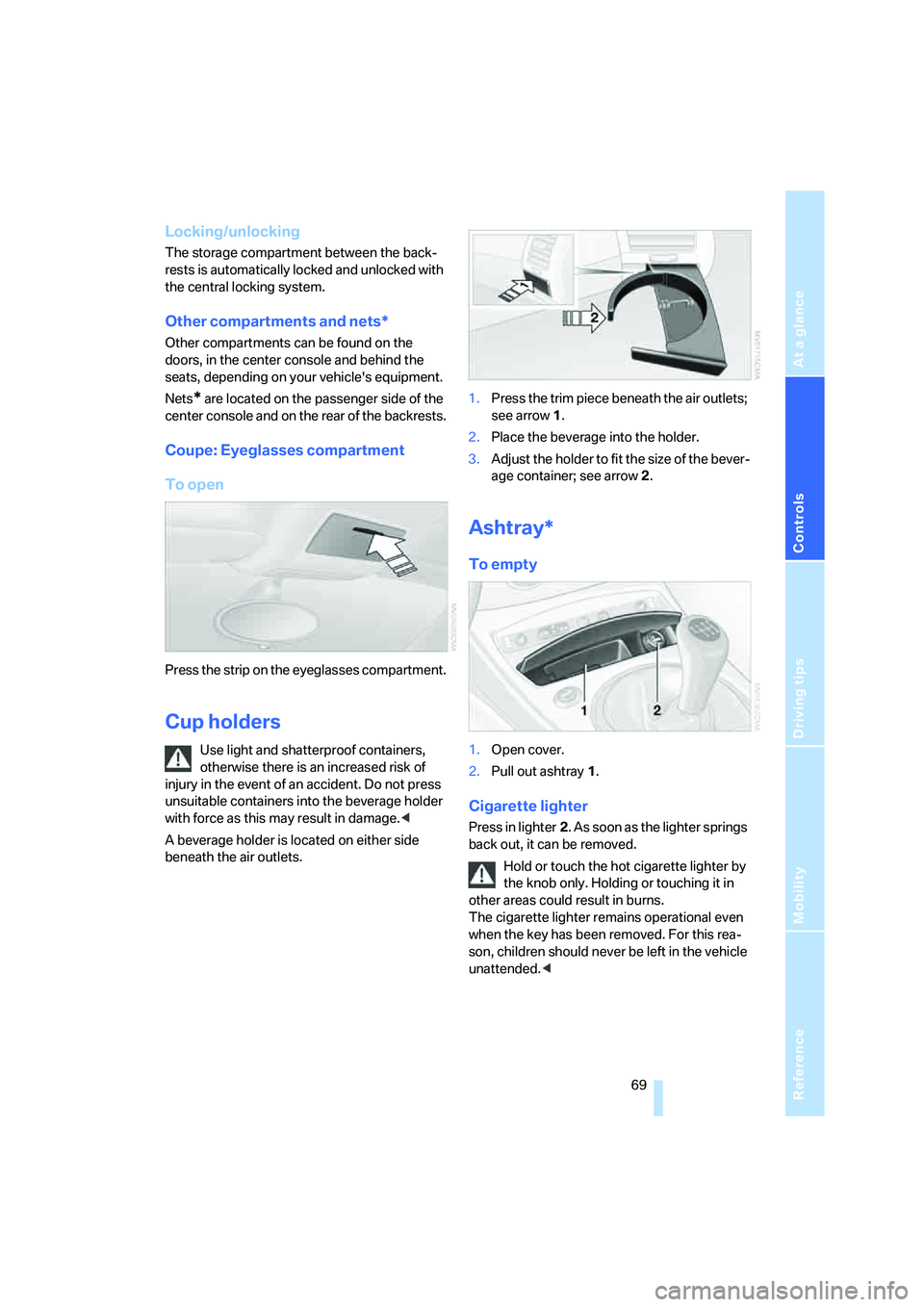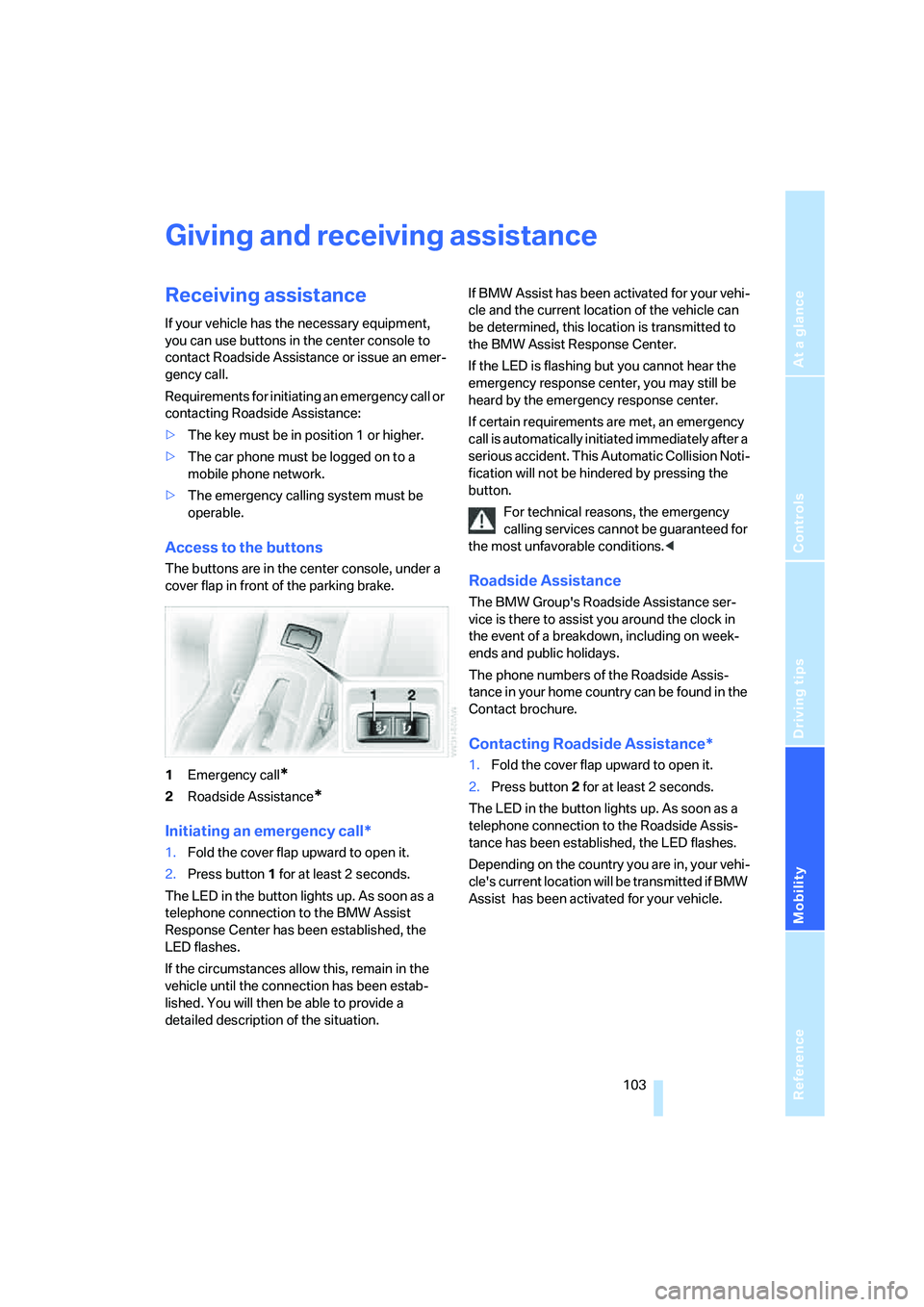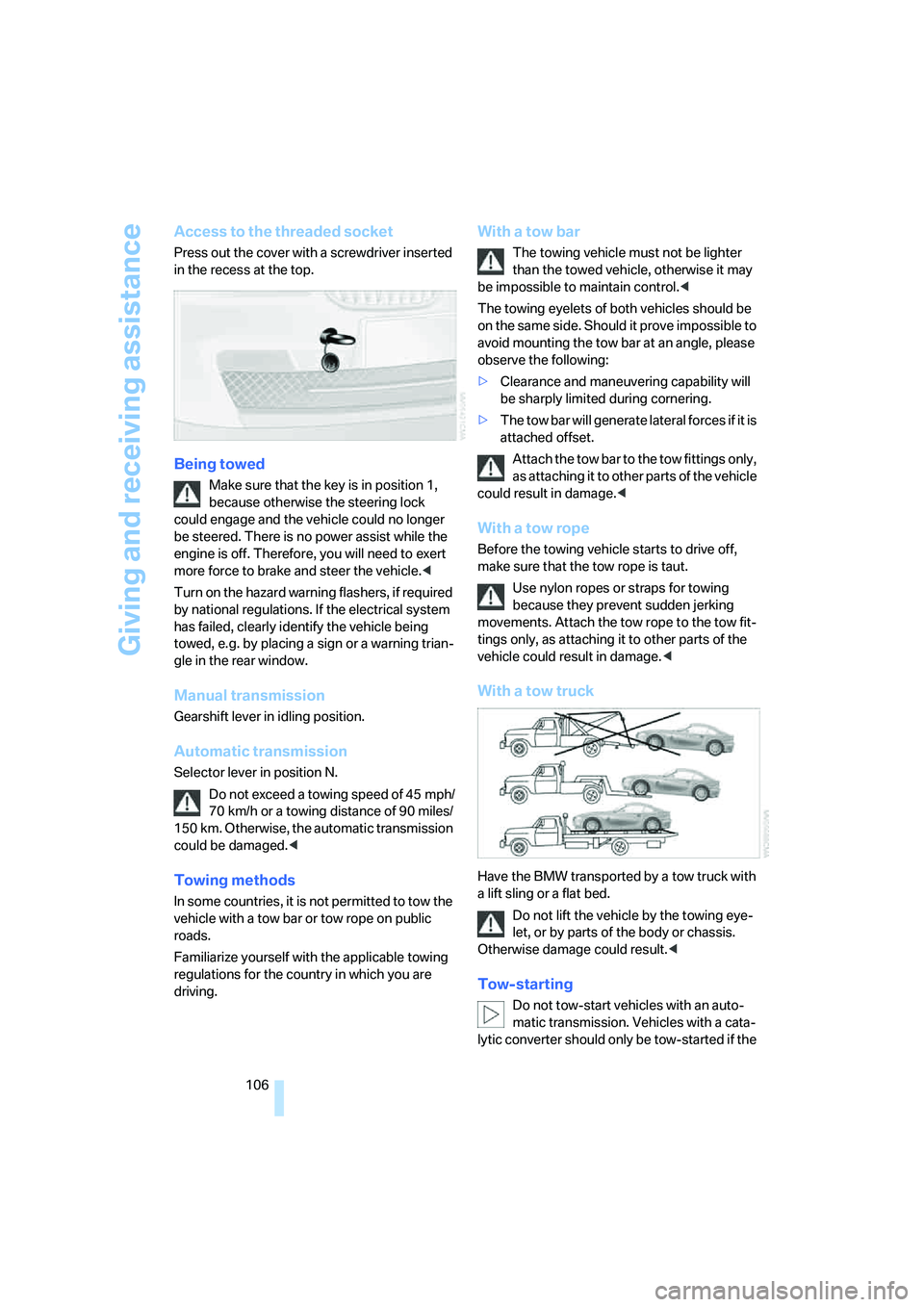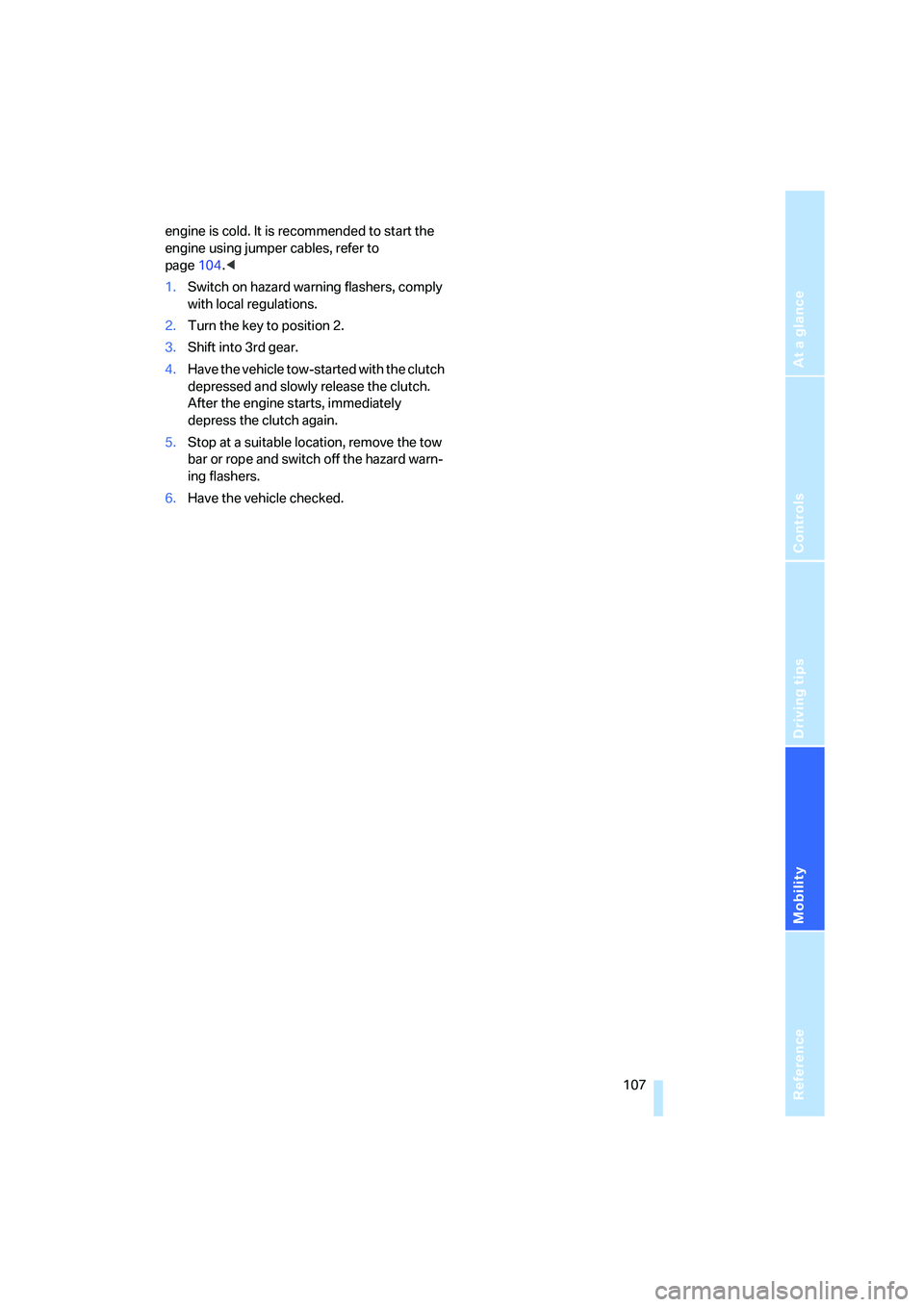2008 BMW Z4 COUPE 3.0SI key
[x] Cancel search: keyPage 71 of 132

Reference
At a glance
Controls
Driving tips
Mobility
69
Locking/unlocking
The storage compartment between the back-
rests is automatically locked and unlocked with
the central locking system.
Other compartments and nets*
Other compartments can be found on the
doors, in the center console and behind the
seats, depending on your vehicle's equipment.
Nets
* are located on the passenger side of the
center console and on the rear of the backrests.
Coupe: Eyeglasses compartment
To open
Press the strip on the eyeglasses compartment.
Cup holders
Use light and shatterproof containers,
otherwise there is an increased risk of
injury in the event of an accident. Do not press
unsuitable containers into the beverage holder
with force as this may result in damage.<
A beverage holder is located on either side
beneath the air outlets.1.Press the trim piece beneath the air outlets;
see arrow1.
2.Place the beverage into the holder.
3.Adjust the holder to fit the size of the bever-
age container; see arrow2.
Ashtray*
To empty
1.Open cover.
2.Pull out ashtray1.
Cigarette lighter
Press in lighter2. As soon as the lighter springs
back out, it can be removed.
Hold or touch the hot cigarette lighter by
the knob only. Holding or touching it in
other areas could result in burns.
The cigarette lighter remains operational even
when the key has been removed. For this rea-
son, children should never be left in the vehicle
unattended.<
Page 105 of 132

Reference
At a glance
Controls
Driving tips
Mobility
103
Giving and receiving assistance
Receiving assistance
If your vehicle has the necessary equipment,
you can use buttons in the center console to
contact Roadside Assistance or issue an emer-
gency call.
Requirements for initiating an emergency call or
contacting Roadside Assistance:
>The key must be in position 1 or higher.
>The car phone must be logged on to a
mobile phone network.
>The emergency calling system must be
operable.
Access to the buttons
The buttons are in the center console, under a
cover flap in front of the parking brake.
1Emergency call
*
2Roadside Assistance*
Initiating an emergency call*
1.Fold the cover flap upward to open it.
2.Press button1 for at least 2 seconds.
The LED in the button lights up. As soon as a
telephone connection to the BMW Assist
Response Center has been established, the
LED flashes.
If the circumstances allow this, remain in the
vehicle until the connection has been estab-
lished. You will then be able to provide a
detailed description of the situation.If BMW Assist has been activated for your vehi-
cle and the current location of the vehicle can
be determined, this location is transmitted to
the BMW Assist Response Center.
If the LED is flashing but you cannot hear the
emergency response center, you may still be
heard by the emergency response center.
If certain requirements are met, an emergency
call is automatically initiated immediately after a
serious accident. This Automatic Collision Noti-
fication will not be hindered by pressing the
button.
For technical reasons, the emergency
calling services cannot be guaranteed for
the most unfavorable conditions.<
Roadside Assistance
The BMW Group's Roadside Assistance ser-
vice is there to assist you around the clock in
the event of a breakdown, including on week-
ends and public holidays.
The phone numbers of the Roadside Assis-
tance in your home country can be found in the
Contact brochure.
Contacting Roadside Assistance*
1.Fold the cover flap upward to open it.
2.Press button2 for at least 2 seconds.
The LED in the button lights up. As soon as a
telephone connection to the Roadside Assis-
tance has been established, the LED flashes.
Depending on the country you are in, your vehi-
cle's current location will be transmitted if BMW
Assist has been activated for your vehicle.
Page 108 of 132

Giving and receiving assistance
106
Access to the threaded socket
Press out the cover with a screwdriver inserted
in the recess at the top.
Being towed
Make sure that the key is in position 1,
because otherwise the steering lock
could engage and the vehicle could no longer
be steered. There is no power assist while the
engine is off. Therefore, you will need to exert
more force to brake and steer the vehicle.<
Turn on the hazard warning flashers, if required
by national regulations. If the electrical system
has failed, clearly identify the vehicle being
towed, e.g. by placing a sign or a warning trian-
gle in the rear window.
Manual transmission
Gearshift lever in idling position.
Automatic transmission
Selector lever in position N.
Do not exceed a towing speed of 45 mph/
70 km/h or a towing distance of 90 miles/
150 km. Otherwise, the automatic transmission
could be damaged.<
Towing methods
In some countries, it is not permitted to tow the
vehicle with a tow bar or tow rope on public
roads.
Familiarize yourself with the applicable towing
regulations for the country in which you are
driving.
With a tow bar
The towing vehicle must not be lighter
than the towed vehicle, otherwise it may
be impossible to maintain control.<
The towing eyelets of both vehicles should be
on the same side. Should it prove impossible to
avoid mounting the tow bar at an angle, please
observe the following:
>Clearance and maneuvering capability will
be sharply limited during cornering.
>The tow bar will generate lateral forces if it is
attached offset.
Attach the tow bar to the tow fittings only,
as attaching it to other parts of the vehicle
could result in damage.<
With a tow rope
Before the towing vehicle starts to drive off,
make sure that the tow rope is taut.
Use nylon ropes or straps for towing
because they prevent sudden jerking
movements. Attach the tow rope to the tow fit-
tings only, as attaching it to other parts of the
vehicle could result in damage.<
With a tow truck
Have the BMW transported by a tow truck with
a lift sling or a flat bed.
Do not lift the vehicle by the towing eye-
let, or by parts of the body or chassis.
Otherwise damage could result.<
Tow-starting
Do not tow-start vehicles with an auto-
matic transmission. Vehicles with a cata-
lytic converter should only be tow-started if the
Page 109 of 132

Reference
At a glance
Controls
Driving tips
Mobility
107
engine is cold. It is recommended to start the
engine using jumper cables, refer to
page104.<
1.Switch on hazard warning flashers, comply
with local regulations.
2.Turn the key to position 2.
3.Shift into 3rd gear.
4.Have the vehicle tow-started with the clutch
depressed and slowly release the clutch.
After the engine starts, immediately
depress the clutch again.
5.Stop at a suitable location, remove the tow
bar or rope and switch off the hazard warn-
ing flashers.
6.Have the vehicle checked.
Page 118 of 132

Everything from A to Z
116
Everything from A to Z
Index
A
ABS Antilock Brake
System51
– indicator lamp12
Accident, refer to Emergency
call103
Acknowledgment signal for
locking/unlocking vehicle19
Activated-charcoal filter for
automatic climate control67
Additives
– coolant94
– engine oil94
Adjusting
– seats30
Adjusting the thigh support32
Airbags56
– deactivating37
– indicator/warning lamp13
– passenger airbags indicator
lamp37
– reactivation37
– safe seating position30
Airbag switch, refer to Key
switch for passenger
airbags36
Air conditioning62
Air-conditioning operation,
refer to Cooling
function63,66
Air distribution
– air conditioning63
– automatic66
– automatic climate control66
– individual63,66
– manual66
Air flow rate
– air conditioning63
– automatic climate control66
Airing out, refer to
Ventilation63,67Air outlets, refer to
Ventilation63,67
Air pressure, refer to Tire
inflation pressure84
Air recirculation, refer to
Recirculated-air
mode63,67
AKI, refer to Fuel
specifications83
Alarm system23
– avoiding unintentional
alarms24
– interior motion sensor24
– switching off an alarm24
– tilt alarm sensor24
All-season tires, refer to
Winter tires87,89
Ambient air, refer to
Recirculated-air
mode63,67
Ambient temperature
display48
Antenna, refer to the Caring
for your vehicle brochure
Antifreeze46,94
– coolant94
– washer fluids46
Antilock Brake System
ABS51
– indicator/warning lamp12
– indicator lamp13
Anti-theft alarm system, refer
to Alarm system23
Anti-theft protection19,23
Approved engine oils94
Artificial leather, refer to the
Caring for your vehicle
brochure
Ashtray69
Assistance systems, refer to
Driving stability control
systems51AUC Automatic recirculated-
air control67
Audio device, external68
Automatic
– air distribution66
– air flow rate66
– cruise control46
– headlamp control59
– luggage compartment lid
operation22
– recirculated-air control
AUC67
– tailgate operation21
Automatic car wash, refer to
the Caring for your vehicle
brochure
Automatic climate control65
Automatic convertible top27
Automatic lamps59
Automatic transmission with
Steptronic42
– indicator lamp13
– interlock40,42
– selector lever43
– selector lever lock42
– shiftlock42
– shift paddles on steering
wheel43
– towing the vehicle106
– tow-starting106
AUTO program for automatic
climate control66
AUX-In jack68
Average fuel consumption50
– setting unit of measure50
Average speed50
– setting unit of measure50
Avoiding unintentional
alarms24
Axle loads, refer to
Weights113
Page 119 of 132

Reference
At a glance
Controls
Driving tips
Mobility
117
B
Backrests, refer to Seat
adjustment31
Backup lamps
– bulb replacement101
Bandages, refer to First-aid
kit104
Bar, refer to Towing
methods106
Battery102
– charging102
– disposal102
– indicator/warning
lamp12,102
– jump-starting104
– power supply
interruption102
– remote control18
Being towed106
Belts, refer to Safety belts33
Belt tensioner, refer to Safety
belts33
Beverage holders69
Blower, refer to Air flow
rate63,66
BMW Homepage4
BMW Maintenance
System96
Bottle holders, refer to
Beverage holders69
Brake assist, refer to Dynamic
Brake Control DBC51
Brake fluid95
– indicator/warning
lamp13,95
– low level95
Brake Force Display56
Brake hydraulics, refer to
Brake system95
Brake hydraulic system
– indicator/warning lamp13
Brake lamps
– brake force display56
– bulb replacement101
– indicator lamp, defective
bulb13Brake pads76
– break-in procedures74
– warning lamp76
Brake pad wear indicator
– brake pads76
– indicator/warning lamp13
Brake rotors76
– brakes76
– break-in procedures74
Brakes
– ABS51
– brake fluid95
– brake pads
76
– braking safely76
– break-in procedures74
– indicator/warning
lamps13,52
– parking brake41
Brake system95
– brake fluid95
– brake pads76
– break-in procedures74
– disc brakes76
– indicator/warning lamp13
Breakdown service, refer to
Roadside Assistance103
Breaking in the clutch74
Breaking in the differential,
refer to Engine and
differential74
Break-in procedures74
Bridging, refer to Jump-
starting104
Bulb changing, refer to Lamps
and bulbs98
Bulb replacement, refer to
Lamps and bulbs98
Buttons on the steering
wheel11
C
California Proposition 65
warning5
Can holders, refer to Beverage
holders69
Capacity
– cargo bay, refer to
Weights113Car battery, refer to Vehicle
battery102
Car care, refer to the Caring
for your vehicle brochure
Care, refer to the Caring for
your vehicle brochure
Care products, refer to the
Caring for your vehicle
brochure
Cargo bay23
– capacity113
– emergency release23
– floor panel98
– increasing capacity23
– opening and closing21,22
– opening from inside the
vehicle21,22
– opening from the outside21
– roll-up cover70
Cargo loading
– stowing cargo77
– vehicle77
Car jack
– jacking points102
Car keys, refer to The key
set18
Carpet care, refer to the
Caring for your vehicle
brochure
Car phone, refer to the
separate Owner's Manual
Car radio, refer to the separate
Owner's Manual
Car wash, refer to the Caring
for your vehicle brochure
Catalytic converter, refer to
Hot exhaust system75
CD changer, refer to Owner's
Manual for Radio/Onboard
Computer
CD operation, refer to Owner's
Manual for Radio/Onboard
Computer
Center console, refer to
Around the center
console14
Center high-mount brake
lamp, bulb replacement101
Page 120 of 132

Everything from A to Z
118 Central locking
– from inside21
Central locking system19
Changes, technical, refer to
For your own safety5
Changing a wheel101
– Run-Flat Tires101
Charge indicator lamp12,102
Check gas cap, indicator
lamp13
Child-restraint mounting
system, LATCH38
Child-restraint systems37
Child seat, refer to Installing
child-restraint systems37
Chrome parts, refer to the
Caring for your vehicle
brochure
Cigarette lighter69
Cleaning the rear window,
refer to the Caring for your
vehicle brochure
Cleaning the vehicle, refer to
the Caring for your vehicle
brochure
Cleaning the windows
– automatically, refer to Rain
sensor45
– reservoir capacity114
– spray nozzles46
– washer/wiper system45
– washer fluid46
– washer fluid reservoir46
Clock49
– 12h/24h mode50
– onboard computer50
– setting50
– setting, refer also to Owner's
Manual for Radio/Onboard
Computer
Clothes hooks71
Cockpit10
Cold start, refer to Starting the
engine40
Combination, wheel/tire88
Comfort area, refer to Around
the center console14Compact disc operation, refer
to Owner's Manual for
Radio/Onboard Computer
Computer50
– button BC50
– clock, 12h/24h mode50
– refer to Owner's Manual for
Onboard Computer
Computer, refer to the
separate Owner's Manual
Condensation, refer to When
the vehicle is parked77
Condensation, removing from
windows
– air conditioning63
– automatic climate control66
Configuring settings, refer to
Vehicle Memory, Key
Memory18
Connecting vacuum cleaner,
refer to Connecting
electrical appliances70
Consumption, refer to
Average fuel
consumption50
Consumption display, refer to
Fuel gauge48
Controls, refer to Cockpit10
Convenience operation
– convertible top20
– from outside20
– windows20
Convertible top25,27
– care, refer to the Caring for
your vehicle brochure
– convenience operation20
– electrical fault28
– emergency closing28
– fully automatic27
– malfunction28
– manual25
– mechanical25
Convertible top compartment
panel23
Coolant94
– checking level94
– indicator lamp13
– thermometer49
Coolant temperature49Coolant water, refer to
Coolant94
Cooling
– maximum66
– refer to Switching cooling
function on/off63,66
Cooling fluid, refer to
Coolant94
Cooling function
– air conditioning63
– automatic climate control66
Cooling system, refer to
Capacities114
Cooling system, refer to
Coolant94
Copyright2
Correct tires89
Cruise control46
Cruising range50
Cup holders, refer to
Beverage holders69
Curb weight, refer to
Weights113
Cylinders, refer to Engine
data110
D
Dashboard, refer to
Cockpit10
Dashboard lighting, refer to
Instrument lighting60
Data, technical
– capacities114
– dimensions111,112
– engine110
– measurements111,112
– weights113
Daytime running lamps59
DBC Dynamic Brake
Control51
– indicator/warning lamp13
Deadlocking, refer to
Locking19
Defective bulb59
Defrosting, windows63,66
Defrosting the windshield,
refer to Defrosting
windows63,66
Page 121 of 132

Reference
At a glance
Controls
Driving tips
Mobility
119
Defrosting windows and
removing condensation
– air conditioning63
– automatic climate control66
Defrost position, refer to
Defrosting windows63,66
Dehumidifying air, refer to
Switching cooling function
on/off63,66
Digital clock49
Dimensions111,112
Dimming mirrors34
Directional indicators, refer to
Turn signal indicators44
Disc brakes76
Displacement, refer to Engine
data110
Display elements, refer to
Instrument cluster12
Display lighting, refer to
Instrument lighting60
Displays, refer to Instrument
cluster12
Displays and controls10
Disposal
– coolant94
– vehicle battery102
Distance remaining, refer to
Cruising range50
Door keys, refer to The key
set18
Door lock20
Doors, unlocking and locking
– acknowledgment
signals19,20
– from inside21
– from outside19
DOT quality grades86
Draft-free ventilation63,67
Drive-off assistance, refer to
Dynamic Stability Control
DSC51
Drive-off assistant52
Driving light, refer to Parking
lamps/Low beams59
Driving notes74,75
Driving off on uphill gradients,
refer to Drive-off
assistant52Driving stability control
systems51
Driving through water76
Driving tips, refer to Driving
notes75
Dry air, refer to Switching
cooling function on/
off63,
66
DSC Dynamic Stability
Control51
– indicator/warning lamp51
– indicator lamp13
DTC Dynamic Traction
Control51
– indicator/warning
lamp13,52
Dynamic Brake Control
DBC51
– indicator/warning lamp13
Dynamic Driving Control44
Dynamic Stability Control
DSC51
– indicator/warning lamp51
Dynamic Traction Control
DTC51
– indicator/warning lamp52
E
EBV Electronic brake-force
distribution51
Electric
– seat adjustment31
Electrical malfunction
– automatic transmission with
Steptronic43
– convertible top28
– door lock20
– fuel filler door82
– luggage compartment lid22
– tailgate22
Electric Power Steering
EPS56
– indicator/warning
lamp13,56
Electric power windows24
Electronic
– brake-force distribution51
– oil level check93Emergency call103
– button103
Emergency operation, refer to
Opening manually
– tailgate22
Emergency release23
Emergency services, refer to
Roadside Assistance103
Engine40
– breaking in74
– electronics13
– indicator lamp13
– overheated, refer to Coolant
thermometer49
– speed48
– starting40
– switching off41
– temperature49
Engine compartment92
Engine coolant, refer to
Coolant94
Engine oil92
– adding94
– additives, refer to Approved
engine oils94
– approved engine oils94
– BMW Maintenance
System96
– change intervals, refer to
Service and Warranty
Information Booklet for US
models, Warranty and
Service Guide Booklet for
Canadian models
– change intervals, refer to
Service interval display49
– checking level93
– indicator/warning lamp12
– oil grades, refer also to
Approved engine oils94
– oil level92
– pressure92
Engine output, refer to Engine
data110
Engine starting, refer to
Starting the engine40
EPS Electric Power
Steering56